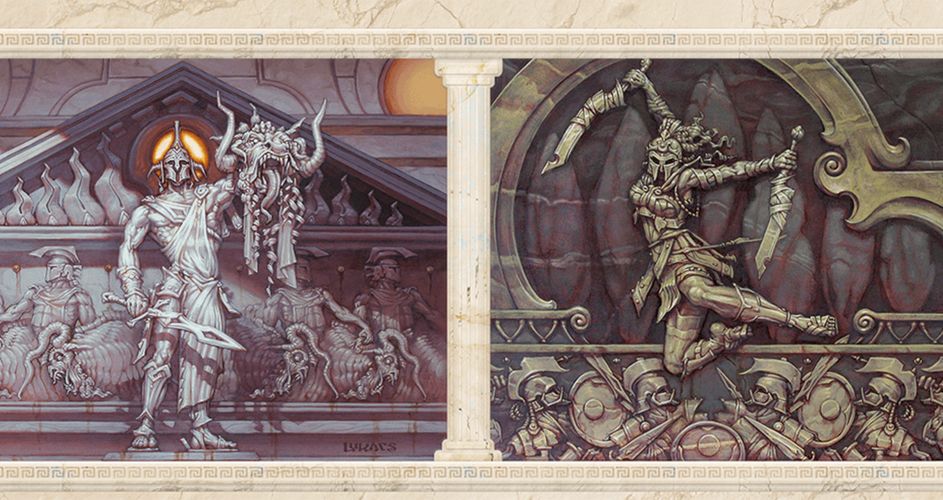
To those unfamiliar with Magic the Gathering, Theros is a plane of existence which takes a page from the myths and legends of Roman and Greek Mythology and mixes it up a new pantheon, new map and new monsters. Now Dungeons & Dragons (aka D&D) is no stranger to turning to the realms of Magic for inspiration – two years ago, the Guildmasters’ Guide to Ravnica was released which brought us to the world-sized city filled with ten guilds. Theros echoes the worldbuilding and new content by providing a similar spread of content for players and dungeon masters to enjoy.
It should also be noted that to help the reader immerse themselves in the setting, the book comes with a plethora of gorgeous illustrations courtesy of some fantastic artists. Depictions of deities, epic struggles, and the world itself…it’s enough to make me want to try and obtain a copy with the alternate cover just so I can marvel as the struggle against the Hydra as captured by Kevin Tong.
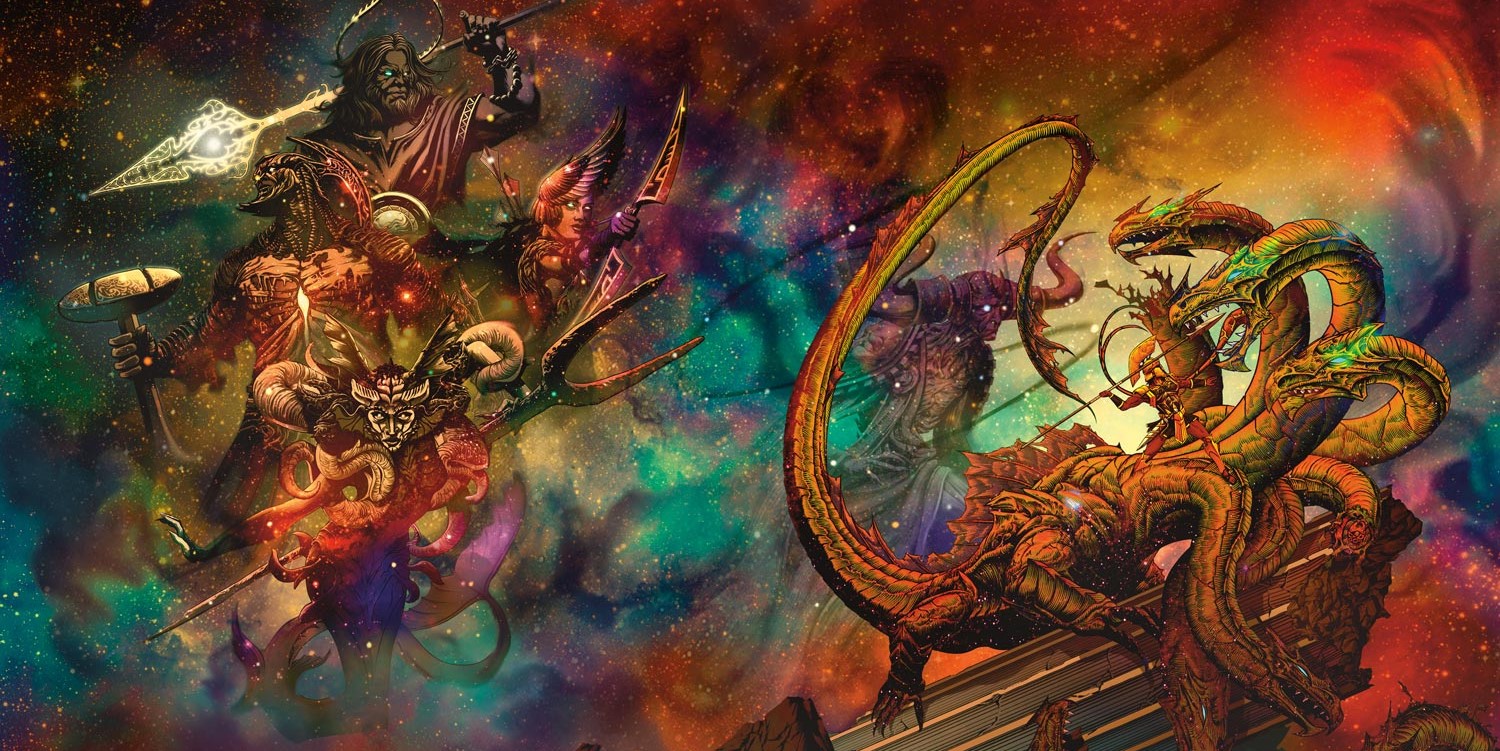
Welcome to Theros.
Despite Theros pre-existing in the Magic card game, much like Ravnica you do not need to enter the realm with a complete understanding of information that is already out there. The sourcebook provides you with all the information you could want, laid out to help explain how Theros takes the Greek Pantheon, and forms is own which are full to the brim of personal goals, intricate rivalries, and prone to meddling in the affairs of mortals. The world of Theros itself seems to be taken straight from the pages of the Iliad or the Aeneid, with all the settlements and monster infested caverns and isles you would expect from the myths and legends. In fact, Theros encourages players to make the connection because here ‘hero’ is an actual vocation and synonymous with adventurers.
The key difference between Theros and traditional D&D Forgotten Realms lies in the power behind and of the gods themselves. In Forgotten Realms, the default setting of 5th Edition, gods exist and help heroes – granting power to clerics, and even favour to paladins – but all in all they’ve taken a step back and have no direct action in the realms. In Theros the gods are as involved as any could believe they could be, and this is because “things believed and dreamed here eventually become real”. The gods themselves are a produce of this process, and it is the continued belief and worship that keep them alive – each story told, every sacrifice made, every devotion is nourishment for these impossible beings.
There is also a theme in Theros, that “the power of fate and myth destines every character for legend; all one must do is act and discover their own immortal tale.” Fate, destiny, and the heroic drive then combine to amplify a character’s ideals, bonds and flaws. It’s understandable that this definition is explained so early in Mythic Odysseys of Theros to set the tone and to help players grasp the core concepts of the world. A brief history of Theros is included at the beginning to give an idea of the background, though those familiar with Magic might find such content to be a little light. I find it useful, as the players can briefly catch up on the establishment of the world whilst the Dungeon Master can have artistic freedom on where to go next without having to extensively revise the dense history.
Player options
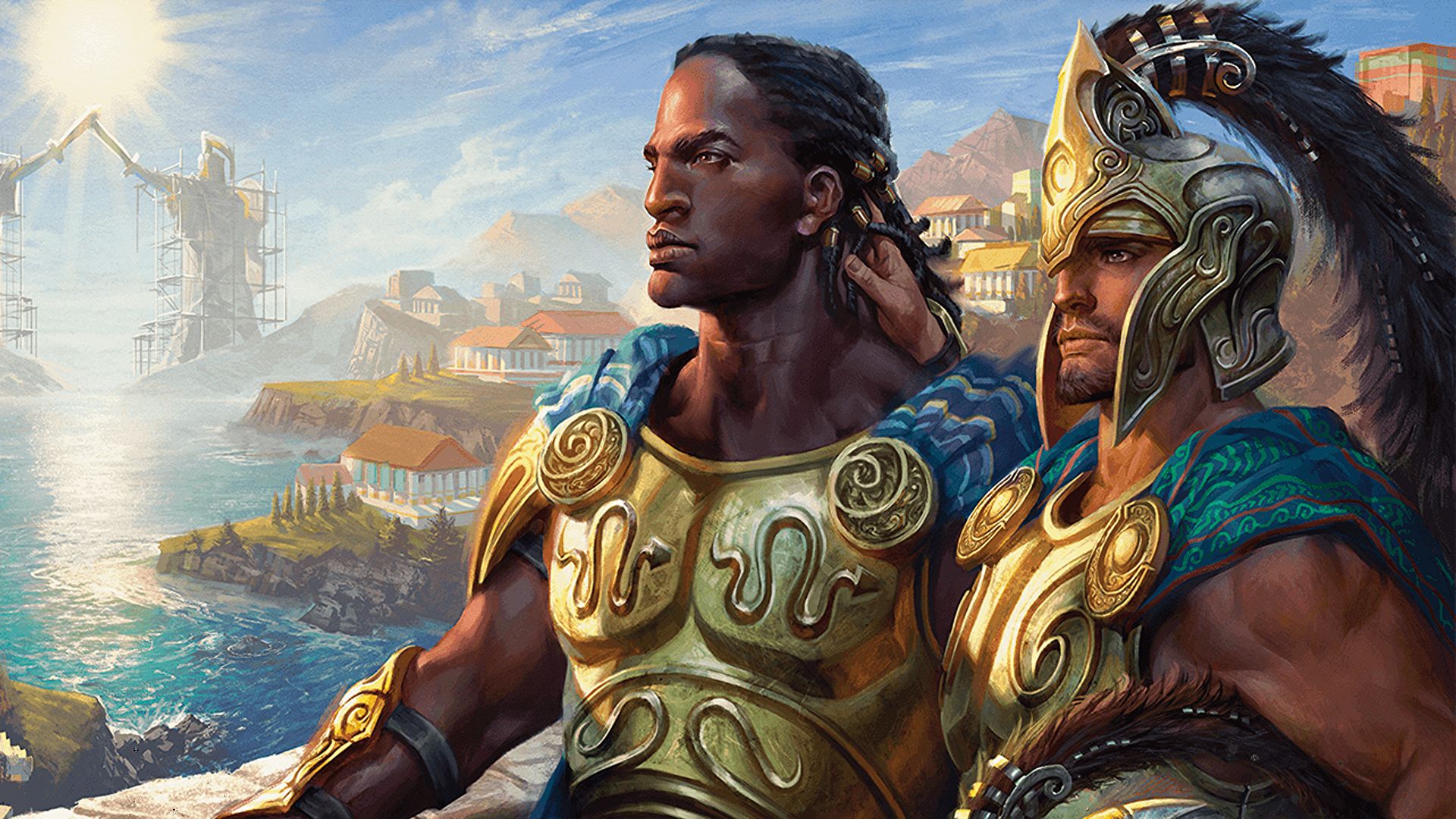
Drive and Gifts
For players, some of the primary content they will focus on is the new features for character creation. In line with the mythic qualities of the realm, the book treats characters as heroes from the start, as all heroes in Theros begin their tale with a Supernatural Gift. These gifts enable characters to set themselves apart from their first level and can be identifiers for the heroic deeds you will undoubtedly undertake in the future!
Each of these Supernatural Gifts act as feats for your character, providing key abilities which will prove to have a use over the course of your odyssey. Perhaps you are Anvilwrought – where you take on the aspects of the Warforged, and have constructed resilience and operate on a Sentry’s Rest to ‘recharge’ for six hours whilst on watch – or perhaps you are Nyxborn – a fragment of divinity, you personify an idea and were born in the gods’ realm. Given your affinity for the divine, you can adopt a cloak of starlight to make it difficult to attack you and have resistance to necrotic and radiant damage.
One particular gift I look forward to trying is that of the Oracle – the gods can commune through you at their leisure and add a d10 to an ability check roll once per long rest. Additionally, you have a curse bestowed upon you (thanks Cassandra) which allows the Dungeon Master to go nuts in terms of visions of a grim future you must avoid, or as a character hook for the other players to try and solve in a quest somewhere along the line.
There is an optional rule for Dungeon Masters to allow a list of feats to be chosen as a Heroic Feat instead if players so desire.
Races
In Theros, there is an interesting limitation to the playable races which occupy these lands. From the Player’s Handbook, only the Humans are noted to live in these lands. The other races feature familiar faces from Ravnica, as we are provided with breakdowns for Centaurs, Minotaurs and Tritons (with a new errata added to allow for Darkvision) as well as two new races – the Satyr and the Leonin.
Each race is given their own specific attention to explore how their societies fit into Theros. The information is fruitful for new adventurers looking for inspiration for their character and how they will fit into the society as a whole. Some little tidbits are particularly insightful, as they can help personally explore and build stories for characters – an example of this lies in how Triton names can set up for unique and quite personal characterisation, such as Tritons having “a fluid concept of gender and might switch names freely as they shift gender identities”.
Players may be drawn to the two new races, and the possibilities they offer. First of all, we have the Leonin. Whilst from the appearance they could be seen as just an alternative form of Tabaxi, this catlike race is more built around health and strength than agility with an ability to make creatures tremble as you stand tall and let out a majestic roar. Proud, noble creatures, they also play a key part in the mythological ecosphere of Theros as being one of the only races where most of the race outright reject gods. They even have a Supernatural Gift crafted especially for their denial of servitude, the Iconoclast.
We also have the Satyr, embracers of life who embody chaos with their revelry and eccentricities. They see the world as a buffet of pleasures, to sample and relish at their leisure. Creatures of charisma and a little dextrous, fey in origin and capable of resisting spells and other magic effects, they make the perfect candidates for spellcasters.
Unfortunately, the book does not introduce any new subraces to the previously existing races. There is an opportunity to be creative with their Supernatural Gifts and introduce this as a flavoured subrace, but I would have liked to have seen some Deep Sea Tritons.
Subclasses
Mythic Odysseys of Theros provide recommendations about pairing cleric domain to deities, but the main draw is the official introduction of two new subclasses which were previously Unearthed Arcana – the Bardic College of Eloquence, and the Paladin’s Oath of Glory.
The new bardic college places an emphasis on the spoken word, allowing for characters pursuing this subclass to excel more in support and roleplay outside of combat. An interesting edit to the subclass which is immediately apparent – Calm Emotions spell is replaced with a variation of the Rogue’s Reliable Talent feature specifically for Persuasion and Deception checks, treating all rolls of 9 or lower as 10. Having this at such a low level will ensure that you’ll want this person to talk to everyone you need something from to get the best deal!
The Oath of Glory does seem to be a more reduced version of Oath of Heroism, though the severity of the reduction might catch a few people off guard. I personally like the change of Legendary Strike to Inspiring Smite, where it turns from making critical attacks easier to distributing hit points as a support move. However, the aura which boosts the movements speed of those very near to you (paired with the worst aura range of all official Paladin subclasses) seems a little too reductive in the capabilities of this subclass. I know it can be used to increase allies and your steed to cover more ground, but people might be put off by just a speed boost.
Finally, the book also introduces only one new background, that of the Athlete. This allows you to envision your character as someone renown for their physical prowess, and have some escapades of athletic events which you and the DM could turn into a small tournament arc (though you will have to choose a favoured event). I can see this to be an opportunity to be expanded for an arc of a campaign, where the heroes take a break to participate in the Olympics only for the events to be disturbed by a slighted athlete looking to disrupt the ceremonies.
The World
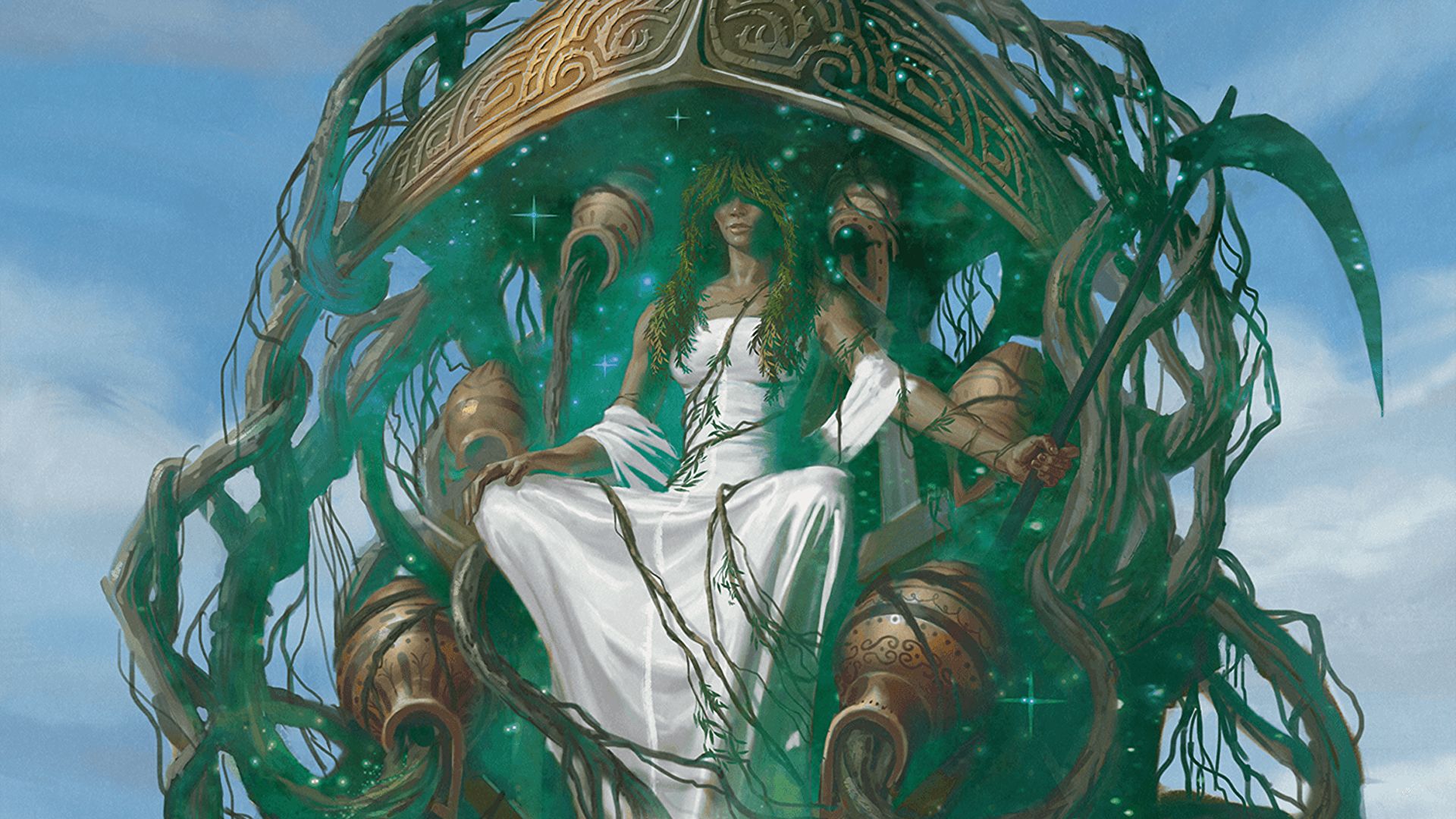
The Gods
As stated before, the pantheon of fifteen gods guide religious life on Theros. Each divine being represents important aspects of mortal life, and can be seen moving across the night sky and may even be encountered face to face. Though they are powerful beings, they lack omnipotence and omniscience – they are still wise enough, having a perfect recall of everything that has happened to them before. They may speak through oracles and seers, manipulate natural phenomena to create oments, and create Nyx-born creatures to serves as messengers and emissaries.
In this setting adventurers can have intimate relationships with the deities of the pantheon, as Theros introduces a Piety System for the Dungeon Master to increase and decrease depending on the actions of particular players to appease a specific deity. Through this system, the gods can bestow favours on those who prove their devotion – depending on the god you have improved relationships with, you gain a unique benefit in accordance with specific levels of piety – 3, 10, 25 and 50. Remember though, the gods are nothing but observant on those who supposedly represent them in the mortal world. Breaking tenants can lead to losing piety points, which can lead to you losing the benefit if you fall below the specific level.
Mythic Odysseys of Theros provides an in-depth look at each of the 15 deities to allow players the opportunity to get to know the ambitions and core aspects of the gods. These profiles also detail each benefit they can obtain through certain deeds and works, as well as some of the myths attributed to that deity.
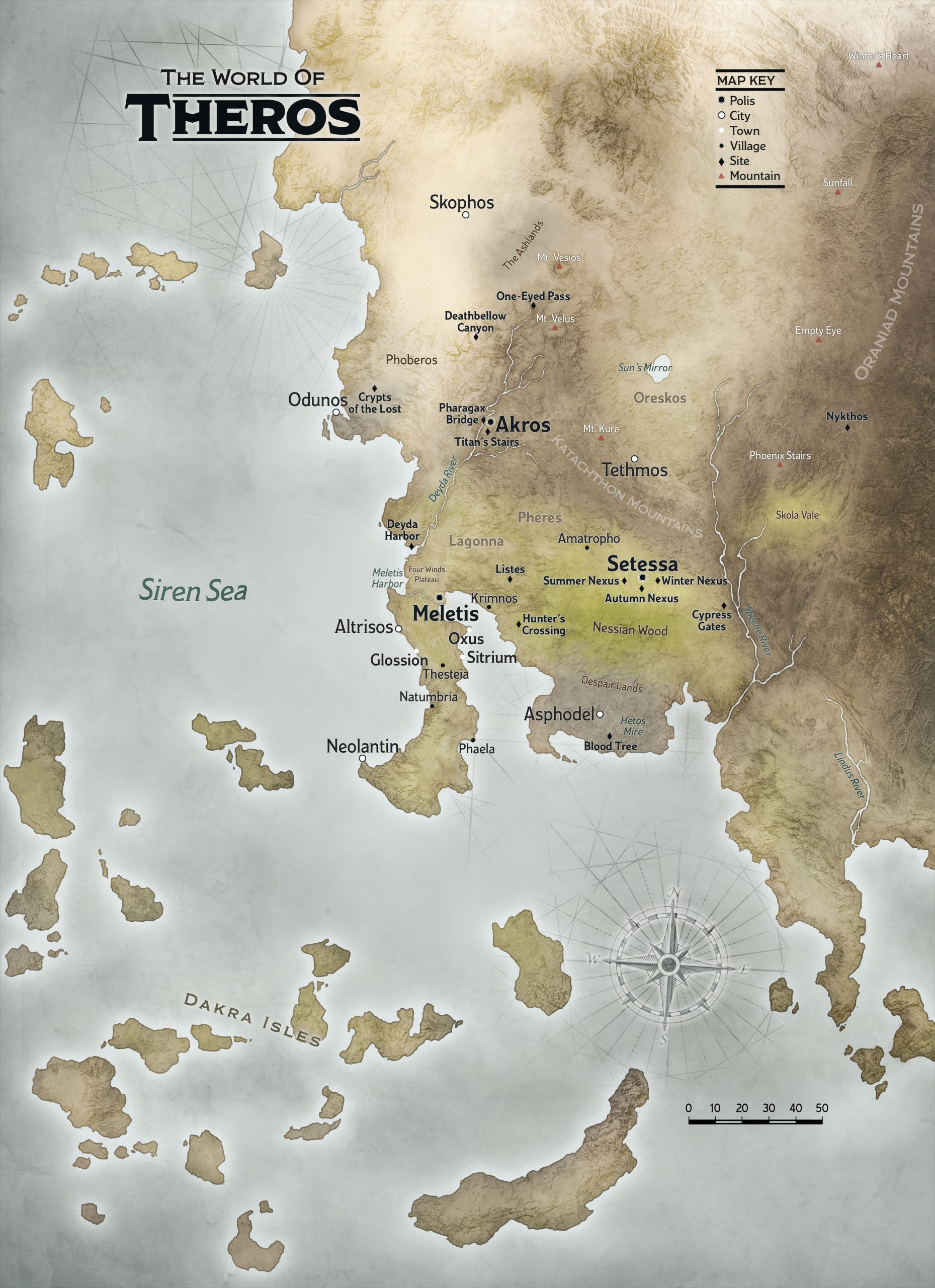
Realms
Within Theros, there is the Mortal Realm and the divine realms of the Nyx and Underworld. Most of Theros consists of a long stretch of coastline sandwiched between the Siren Sea and the Oraniad Mountains. Inland, there are three poleis (large cities and surrounding territories). Within Akros, Meletis and Setessa are different political structures which offer their citizens safety and a home. The book provides some much needed context for each poleis, and parralels can be drawn with the legends of ancient Athens, Sparta and Troy. Key features of the world are expanded upon within the book to give players and Dungeon Masters all the ideas of how the places exist on a day-to-day basis and what can be expected (or built upon by Dungeon Masters who might lay about with the material for their campaigns). Attention is also given to the other realms of Theros which players might visit in their adventures. Anyone up for plunging into the depths of the Underworld to retrieve a lost soul wrongly punished?
Monsters & Adventures
Mythic Odysseys of Theros would not be comeplete without some fantastically laid out adventures waiting to be utilised by Dungeon Masters. An entire chapter is dedicated to the deities of the realm and key adventures that players may embark on related to that deity, whether they be the patrons providing these challenges or the ultimate antagonist for the players to foil.
And it wouldn’t be an Odyssey without any monsters to challenge the players along the way! Each creature has been sourced from mythology and the Magic game itself, utilising some of the card artwork to bring creatures to life! Classic monsters such as the Cyclops and Lamia are taken straight from the Monster Manual, but introduces the new Cerberi and Hydras to challenge even the most seasoned adventurers! And, to add an extra layer of challenge to encounters, Theros introduces three Mythic Monsters with Mythic Traits which can change battles into truly legendary climaxes as they refuse to die. For example, Arasta (whose lovely web-covered visage can be seen above) will immediately regain 200 hit points and gains a swarm of baby spiders which provide an additional 100 hit points.
Finally, what adventure wouldn’t be complete without treasures! Magical items – such as the Two-Birds sling which allows ammunition to ricochet to a second target with each attack, or the wonderous Helm of the Gods which provides a different boon depending on which deity you worship. Or perhaps you eventually stumble on one of the five artifacts, godly in origin and carrying some impressive power within.
Final Thoughts
Ever since the inclusion of Ravnica to D&D 5th Edition, I have been curious about what could come next. What new setting and stories could possibly come forth from Magic or elsewhere. Recently, it seems that 5e is looking to explore all possible realms and places from, as Theros is a welcome addition to the settings to play about in, appealing to both those familiar through Magic or completely new and just familiar with the Greek myths and heroes of old. The new Piety System makes for an interesting addition to the mechanics of the game to get players all engaged with the divine cosmos, and the Supernatural Gifts ensure that players start their campaigns off already feeling sure and confident in themselves as they start their journey to embark on Odysseys of their own.











